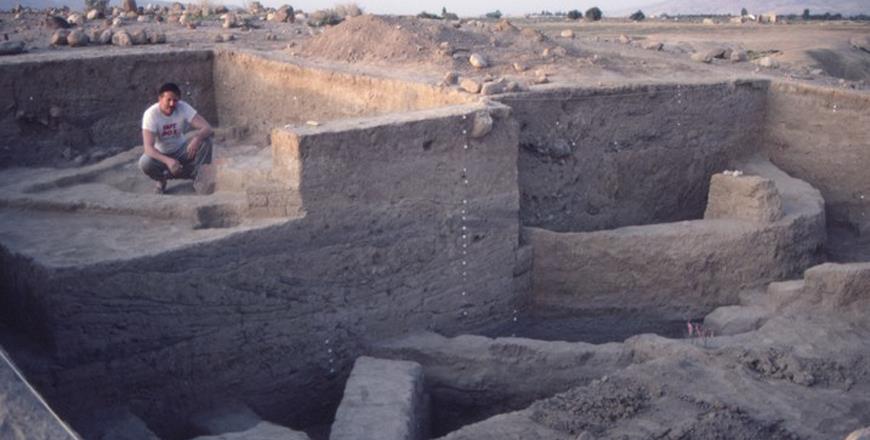
Tell Umm Hammad Reveals Insights Into Early Bronze Age Settlements, Artefacts
The site is placed approximately 230 metres below sea level and is situated on the fertile Lisan marls and Quaternary deposits of the Zarqa River's alluvial fan.
The climate of the central Jordan Valley is characterised by hot and dry summers and cool, wet winters. Consequently, rainfall peaks in December and January, with the site receiving on average 277 millimetres of rainfall per annum, making both dry farming and irrigation agriculture viable at the site.
There are two mounds at Tell Umm Hammad - Umm Hammad Al Sharqi and Tell Umm Hammad Al Gharbi and these two occupational areas are situated some 600 m apart, indicating that the site is both horizontally and vertically.
“A large cemetery has also been identified approximately 300 metres southwest of Tell Umm Hammad Al Gharbi and the full extent of the cemetery has not yet been ascertained, although it is believed to run for approximately 1.5 km along the north-western bank of the Zarqa River, making it one of the largest known Early Bronze IV cemeteries in the southern Levant,” said Melissa Kennedy from The University of Western Australia.
Kennedy added that despite the presence of deep stratified deposits at Tell Umm Hammad, the construction of a comprehensive stratigraphic framework has been complicated by numerous factors such as erosion, deflation, and cultivation.
Excavations at Tell Umm Hammad Al Sharqi uncovered extensive occupational remains dating to the EB I–II, with the EB IV settlement positioned directly atop these horizons. EB IV occupation was distinguished by a series of simple, mud-brick domestic structures and associated installations, such as pits and hearths.
“Excavations and surface clearances at Tell Umm Hammad Al Gharbi also revealed an extensive settlement, which can be divided into three stages and nine subphases of occupation. This sector of the site appears to have been occupied somewhat later than Tell Umm Hammad Al Sharqi, with internal distinctions based on architectural developments and ceramic analysis,” Kennedy underlined.
She noted that relating to these EB IV stages and phases of occupation were a number of large domestic complexes that increased significantly in size and complexity as the period proceeded.
These dwellings were constructed in the“broad-room” tradition characteristic of the Early Bronze Age, with most dwellings found in association with courtyards and domestic installations, such as ovens and silos/pits, and the settlement was divided into a series of residential insulae by a 2 m wide lane or street, suggesting a high degree of planning and social complexity.
Kennedy stated that this is despite the fact that the EB IV has generally been perceived to be an era of urban and social retrogression. Similar and contemporary settlement plans have also been identified farther south, at Tell Iktanu on the Wadi Hesban and in the northern Jordan Valley at Shaʿar Hagolan.
In 1982, the archaeological team discovered a complete jar and in terms of form, the jar can correlate with round ad lat0based jars characterised by a variety of out-laring/everted rim forms, Kennedy emphasised.
“This vessel is distinguished by a globular body form and is internally thickened, with a sharp internal carination at the neck–shoulder juncture. The rim differs somewhat from the traditional Tell Umm Hammad jar corpus, with an upright, out laring, downturned, beaded, rounded rim form,” Kennedy outlined.
The vessel has a rim diameter of 10 cm and is decorated from the rim to the base of the vessel with multiple horizontal registers of incised wavy bands, diagonal slashes, and short bands of horizontal incisions. The wavy-band incision appears to have been rendered by a five-tooth comb, characteristic of the EB IV period, Kennedy underlined, adding that the vessel is fashioned in a medium pinkish-red fabric.
In relative chronological terms, this repertoire dates late within the Tell Umm Hammad Al Gharbi sequence, with examples increasing in frequency until the final abandonment of the settlement at the end.
“Almost all vessel classes, with the exception of loop-handled amphoriskoi, can be associated with this repertoire or grouping. Repertoire R5 vessels are distinguished by homogeneous pinkish-red fabrics with innetomedium-coarse grit and vegetal tempers,” Kennedy elaborated, noting that other distinguishing features include incised wavy-band decoration, jars with developed or complex rims, along with molded and incised bands of decoration at the neck–shoulder juncture and on the body of the vessel.

Legal Disclaimer:
MENAFN provides the
information “as is” without warranty of any kind. We do not accept
any responsibility or liability for the accuracy, content, images,
videos, licenses, completeness, legality, or reliability of the information
contained in this article. If you have any complaints or copyright
issues related to this article, kindly contact the provider above.
Most popular stories
Market Research
- Thinkmarkets Adds Synthetic Indices To Its Product Offering
- Ethereum Startup Agoralend Opens Fresh Fundraise After Oversubscribed $300,000 Round.
- KOR Closes Series B Funding To Accelerate Global Growth
- Wise Wolves Corporation Launches Unified Brand To Power The Next Era Of Cross-Border Finance
- Lombard And Story Partner To Revolutionize Creator Economy Via Bitcoin-Backed Infrastructure
- FBS AI Assistant Helps Traders Skip Market Noise And Focus On Strategy




















Comments
No comment